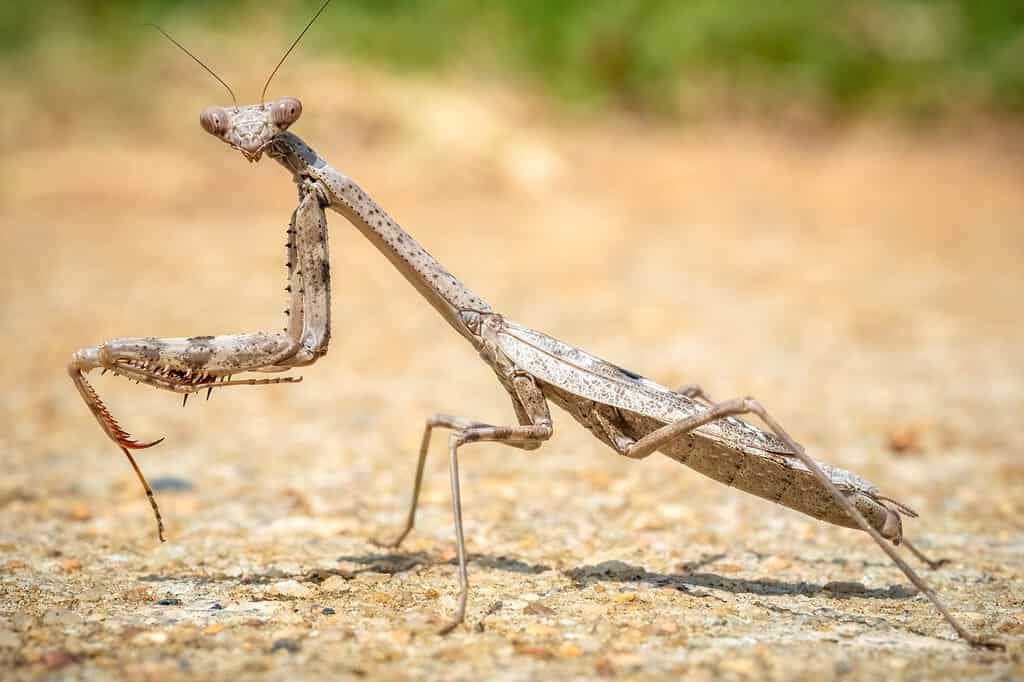You may have seen them on your door or wall. Ultimately, they are curious little critters that can hang on trees, doors, and walls. But they are completely different animals than other insects, such as flies and spiders. Thus, they are not as prominent or known as those insects. The praying mantis is a curious insect. Overall, they have been around for millions of years, and people often find amazement when they see them. But are praying mantis endangered? And is it illegal to kill them? We are here to share facts about this insect and answer that question.

Praying mantids are harmless to humans, but they enjoy eating grasshoppers.
©samray/Shutterstock.com
The Praying Mantis: Species Profiles
The praying mantis is harmless to humans. Hence, it is not an animal you should fear. Instead, you will likely see an animal that enjoys hanging around in any environment they can find. The praying mantis comes from the Mantidae family, according to the Missouri Department of Conservation.
You may see a praying mantis in a vegetated area, such as a garden, oil field, or pasture. They also frequent woodland borders and other areas that have numerous plants. There are several different kinds of mantids. Significantly, there are North American, Chinese, and European variations.
Fun Facts About the Praying Mantis
The praying mantis is an interesting insect. Therefore, you will find some intriguing facts about the animal. They get their names from their legs, according to the Forest Preserve District Will County. The praying mantis looks like it is praying when it is in one of their stances.
Praying mantids are also exceptional at hiding in plain sight, camouflaging themselves from any potential predators or prey. Moreover, this causes them to change colors when they need to.
Praying mantids also sometimes engage in cannibalism. Unfortunately for some male mantids, mating season can be dangerous as the female praying mantis sometimes bite his head off during the process. The male will continue trying to mate even while the female is eating him. Consequently, this behavior happens 25 percent of the time.
The praying mantis can also amazingly turn its head 180 degrees, which helps them hunt. Amazingly, this is a very rare trait among insects.
Mantids go through three stages of life, according to the Connecticut Agricultural Experimental Station. Ultimately, these stages are egg, nymph, and adult. After the praying mantis hatched, it goes through the adolescence stage before eventually becoming an adult.

The praying mantis will find any place to hang around, and you might find them near your garden.
©Lauren Suryanata/Shutterstock.com
Where You Will Find Praying Mantis
But are praying mantis endangered? Before we answer that, we will tell you where you can find them. Amazingly, you can find praying mantids across North America, Southern Africa, and Southern Europe. The praying mantis arrived in North America in the late 1800s as farmers wanted to get rid of pests in their crops, according to the New York State Department of Environmental Conservation.
Praying mantids will emerge in your plants or in the grass. Likewise, you will be more likely to see more of them in the spring and the summertime.
The Praying Mantis: Endangered Status
Are praying mantis endangered? No, they are not currently endangered. To current given knowledge, they have not endured any endangered status at any moment in history. They are actually more widespread than ever before.
Is It Illegal to Kill Them?
It is not illegal to kill them. However, it is frowned upon. There was a weird story where a man went on the run because he believed that killing a praying mantis was illegal. Amazingly, he went missing for a few years. But where did that strange rumor start?
You would have to go all the way back to the 1950s to discover the true reason, as someone alleged that killing a praying mantis resulted in a $50 fine. However, there is no truth to that, as there has never been anything concrete around the world about how killing a praying mantis would result in a fine.
There may be some parts of the world that consider the praying mantis a protected species. Regardless, it is not a thing in North America.
Nothing bad will happen to you if you kill a praying mantis, at least not legally. However, if you do this in a country where people worship the praying mantis, you might encounter trouble. Many people are fond of the praying mantis and will be upset if you harm them.
Praying Mantis Population Around the World
There are allegedly over 2,400 variations of praying mantis across the world. Ultimately, many of them are average size. But there are some large praying mantis in the world. The Giant African Stick Mantis is the largest variation of the praying mantis you will find worldwide.
The praying mantis continues to thrive worldwide. Subsequently, it will not be difficult to find them in your own backyard. While it is not illegal to kill them, remember that they protect the plants and will eat all the pests.

Some praying mantis, like the Giant African Mantis, hang on branches before getting food.
©Karel Bartik/Shutterstock.com
The photo featured at the top of this post is © Ryzhkov Oleksandr/Shutterstock.com
Thank you for reading! Have some feedback for us? Contact the AZ Animals editorial team.







